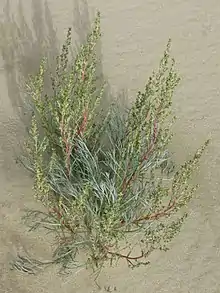| Artemisia borealis | |
|---|---|
 | |
| Scientific classification | |
| Kingdom: | Plantae |
| Clade: | Tracheophytes |
| Clade: | Angiosperms |
| Clade: | Eudicots |
| Clade: | Asterids |
| Order: | Asterales |
| Family: | Asteraceae |
| Genus: | Artemisia |
| Species: | A. borealis |
| Binomial name | |
| Artemisia borealis Pall. 1776 not Kitam. 1934 nor Liou date unknown | |
| Synonyms[2] | |
|
Synonymy
| |
Artemisia borealis is an arctic and alpine species of plant in the sunflower family, commonly known as northern wormwood, boreal sage, boreal wormwood or boreal sagewort.[3] It is native to high latitudes and high elevations in Eurasia and North America. In North America, it can be found in Alaska, Greenland, the Canadian Arctic, and the Rockies, Cascades, and Sierra Nevada as far south as Arizona and New Mexico.[4][5] In Eurasia, it is widespread across European and Asiatic Russia[6] and also grows in Scandinavia and in the mountains of central Europe (Carpathians, Alps, etc.)[7][8][9]
Description
Perennials, (6–)8–20(–40) cm (caespitose), mildly aromatic; taprooted, caudices branched. Stems (1–)2–5, gray-green, tomentose. Leaves persistent, basal rosettes persistent, gray-green to white; blades ovate, 2–4 × 0.5–1 cm, 2–3-pinnately or -ternately lobed, lobes linear to narrowly oblong, apices acute, faces moderately to densely sericeous. Heads (proximal sessile, distal pedunculate) in (leafy) spiciform arrays 4–9(–12) × (0.5–)1–5 cm. Involucres hemispheric, 3–4 × 3.5–4 mm. Phyllaries (obscurely scarious) densely tomentose-villous. Florets: pistillate 8–10; functionally staminate 15–30; corollas (or lobes) yellow-orange or deep red, 2.2–3.5. Cypselae oblong-lanceoloid, somewhat compressed, 0.4–1 millimetre (0.016–0.039 in), faintly nerved, glabrous.[4]
References
- ↑ "NatureServe Explorer 2.0". explorer.natureserve.org. Retrieved 2023-10-23.
- ↑ The Plant List, Artemisia borealis Pall.
- ↑ Natural Resources Canada, Canada's Plant Hardiness Site, Artemisia borealis Pall.
- 1 2 Flora of North America Vol. 19, 20 and 21 Page 505 Artemisia borealis Pallas, Reise Russ. Reich. 3: 755. 1776.
- ↑ Biota of North America Program 2014 state-level distribution map
- ↑ "Panarctic Flora, Artemisia borealis Pall". Archived from the original on 2015-07-03. Retrieved 2015-05-23.
- ↑ Atlas roślin naczyniowych Polski, Atlas of Vascular Plants of Poland in Polish with photos
- ↑ Flore Alpes, Armoise boréale, Artemisia campestris subsp. borealis in French with photos
- ↑ Altervista Flora Italiana, Artemisia campestris subsp. borealis (Pall.) H. M. Hall & Clem.
